59th Street station (BMT Fourth Avenue Line)
59th Street is an express station on the BMT Fourth Avenue Line of the New York City Subway. Located at 59th Street and Fourth Avenue in Sunset Park, Brooklyn, it is served by the N and R trains at all times, as well as some W trains during rush hours.
59 Street | |||||||||||||||
|---|---|---|---|---|---|---|---|---|---|---|---|---|---|---|---|
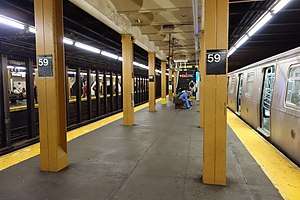 The downtown platform | |||||||||||||||
| Station statistics | |||||||||||||||
| Address | 59th Street & Fourth Avenue Brooklyn, NY 11220[1] | ||||||||||||||
| Borough | Brooklyn | ||||||||||||||
| Locale | Sunset Park | ||||||||||||||
| Coordinates | 40°38′29″N 74°01′04″W | ||||||||||||||
| Division | B (BMT) | ||||||||||||||
| Line | BMT Fourth Avenue Line | ||||||||||||||
| Services | N R W | ||||||||||||||
| Transit connections | ⛴ NYC Ferry: Rockaway and South Brooklyn routes (at Brooklyn Army Terminal)[3] | ||||||||||||||
| Structure | Underground | ||||||||||||||
| Platforms | 2 island platforms cross-platform interchange | ||||||||||||||
| Tracks | 4 | ||||||||||||||
| Other information | |||||||||||||||
| Opened | June 22, 1915[4] | ||||||||||||||
| Station code | 035[5] | ||||||||||||||
| Accessible | not ADA-accessible; currently undergoing renovations for ADA access | ||||||||||||||
| Accessibility | Cross-platform wheelchair transfer available | ||||||||||||||
| Opposite-direction transfer available | Yes | ||||||||||||||
| Traffic | |||||||||||||||
| Passengers (2019) | 3,664,480[6] | ||||||||||||||
| Rank | 138 out of 424[6] | ||||||||||||||
| Station succession | |||||||||||||||
| Next north | 36th Street (express): N 53rd Street (local): N | ||||||||||||||
| Next south | Eighth Avenue (Sea Beach): N Bay Ridge Avenue (Bay Ridge): R | ||||||||||||||
| |||||||||||||||
| |||||||||||||||
| |||||||||||||||
The 59th Street station was constructed as part of the Fourth Avenue Line, which was approved in 1905. Construction on the segment of the line that includes 59th Street started on March 15, 1913, and was completed in 1915. The station opened on June 22, 1915, as the southernmost station of the initial portion of the BMT Fourth Avenue Line. The station's platforms were lengthened in 1926–1927,[7] and again during the 1960s.[8] The 59th Street station is also being renovated between 2018 and 2020, and elevators are being added to make the station compliant with the Americans with Disabilities Act of 1990.
History
Construction
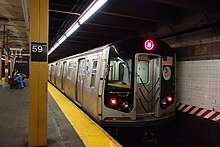
The 59th Street station was constructed as part of the Fourth Avenue Line, the plan for which was initially adopted on June 1, 1905.[9] The Rapid Transit Commission was succeeded on July 1, 1907, by the New York State Public Service Commission (PSC), which approved the plan for the line in late 1907.[10][11]
As part of negotiations between New York City, the Brooklyn Rapid Transit Company (BRT), and the Interborough Rapid Transit Company for the expansion of the city's transit network, the line was leased to a subsidiary of the BRT. The agreement, known as Contract 4 of the Dual Contracts, was signed on March 19, 1913.[10] In 1912, during the Dual System negotiations, the construction of an extension of the Fourth Avenue subway from 43rd Street to 89th Street, just south of the 86th Street station, was recommended. The proposal was approved by the Board of Estimate on February 15, 1912. The PSC directed its chief engineer to create plans on June 14, 1912. The two contracts for the extension, Route 11B, were awarded on September 16, 1912, to Degnon Construction Company for a combined $3.8 million (equivalent to $100.7 million in 2019).[12]
Construction on Route 11B1, the section of the extension between 43rd Street and 61st Street, which includes the 59th Street station, began on March 15, 1913. Originally, this section was planned to have two tracks, but after the connection to the Sea Beach Line was added to the plan during the middle of construction, the plan was changed to four tracks. This section was completed in 1915.[9] 59th Street opened on June 22, 1915, as part of an extension of the subway to Coney Island station, which included the segment of the Fourth Avenue Line to the north of the station, as well as the entire Sea Beach Line to the south.[13][4] The station's opening was marked with a competition between two trains heading from Chambers Street station in Manhattan to the Coney Island station, one heading via the West End Line and the other via the Sea Beach Line; the latter got to Coney Island first.[4] Since 59th Street was an express station, the platforms were originally 480 feet (150 m) long, allowing eight-car express trains to stop there.[12]
Renovations
On June 27, 1922, the New York State Transit Commission directed its engineers to prepare plans to lengthen the platforms at 23 stations on the lines of the Brooklyn–Manhattan Transit Corporation (BMT), the successor to the BRT, to accommodate eight-car trains. As part of the project, 59th Street's platforms would have been lengthened from 480 feet (150 m) to 530 feet (160 m).[14][15] Though the Transit Commission ordered the BMT to lengthen these platforms in September 1923, progress on the extensions did not occur until February 16, 1925, when the New York City Board of Transportation (NYCBOT) directed its engineers to prepare plans to lengthen the platforms at this and eleven other stations along the Fourth Avenue Line. It estimated the project's cost to be $633,000 (equivalent to $9,228,000 in 2019).[16] The NYCBOT received bids for the project on February 25, 1926.[17] The contract was awarded to Corson Construction Company for $345,021 (equivalent to $4,983,000 in 2019).[18] The extensions opened on August 1, 1927.[7]
1960s
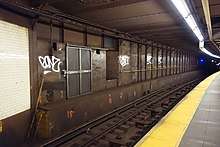
In the 1960s, the New York City Transit Authority (NYCTA) started a project to lengthen station platforms on its lines in Southern Brooklyn to 615 feet (187 m) to accommodate 10-car trains.[8] On July 14, 1967, the NYCTA awarded a contract to conduct test borings at eleven stations on the Fourth Avenue Line, including 59th Street, to W. M. Walsh Corporation for $6,585 (equivalent to $50,492 in 2019) in preparation of the construction of platform extensions.[19] The NYCTA issued an invitation for bids on the project to extend the platforms at stations along the Fourth Avenue Line between 45th Street station and Bay Ridge–95th Street, including this station, on May 3, 1968.[20] However, work had already started on the platform extension project in February. The platforms were extended by 85 feet (26 m) to the north.[21]
2010s
Elevator access for this station has been proposed for the late 2010s. However, the installation of elevators has been delayed due to a column replacement project above this section of the Fourth Avenue Line. Both the column replacement and the elevator installation require temporary lane closures on Fourth Avenue, a major artery. An elevator contract was supposed to be awarded in November 2016, but was pushed back to July 2018.[22] A $55.2 million contract for the installation of three elevators at the 59th Street station was awarded in late 2018,[23] and substantial completion is expected in July 2020.[24]
Station layout
| G | Street level | Exit/entrance |
| M | Mezzanine | Fare control, station agent |
| B Platform level |
Northbound local | ← ← ← |
| Island platform | ||
| Northbound express | ← | |
| Southbound express | | |
| Island platform | ||
| Southbound local | | |
This station is the southernmost four-track express station on the Fourth Avenue Line with two island platforms. South of the station, there are two diamond crossovers, allowing trains to cross between each pair of local and express tracks. The local tracks continue along Fourth Avenue to Bay Ridge–95th Street while the express tracks turn east and become the BMT Sea Beach Line.[25] The N and R stop here at all times, while some rush-hour W trains stop here in the peak direction.[26][27][28]
The station walls have mosaic trim lines on top of the white tiles, and spell 59th Street at intervals.[29] The northern sections of the station are where the platforms were extended in 1970, and they have no mosaic trims or tiles along the wall, instead including an extension of the tunnel benchwall.[30] Two sets of columns run along the entire length of both platforms and are painted yellow.[31] The mosaic trim lines are also present in the mezzanines. At the top of the pairs of staircases to each of the platforms, in the trim lines, there are directional mosaics.[32] Those to the Brooklyn-bound platform say "UP TOWN TRAINS",[33] while those to the Manhattan-bound platform say "DOWN TOWN TRAINS".[34]
Exits
The street-level entrances are at the southern end of the station, with one entrance along either side of Fourth Avenue between 60th and 61st Streets. This part-time exit is unstaffed and has High Entry-Exit Turnstiles.[35] There are also four exits to Fourth Avenue and 59th Street, with two each to either northern corner, at the north end of the station.[36] Each entrance has its own small mezzanine, and allows for crossovers between platforms.[32][37]
Provisions for proposed extensions
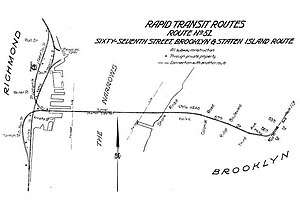
Immediately south of the station, there are tunnel stub headings running straight from the local tracks. They run for about 150 feet (46 m) and would have been for a line to Staten Island via the Staten Island Tunnel under the Narrows, which was aborted by Mayor Hylan before it was completed.[38][39] There is a "maintenance of way" shed that was built on the southbound trackway.[40] The northbound trackway is unobstructed, albeit much darker.[41] The northbound trackway ends on a brick wall, with evidence of a void space beyond. South of this station, the bridge over the LIRR Bay Ridge Branch has four trackways, with the outer tracks occupying the two western ones. The tracks of the BMT Fourth Avenue Line are under the western half of Fourth Avenue at this point so that two additional tracks could be laid in the future if traffic warranted it.[9][42]
The original proposal planned a connection from a point between 65th and 67th Streets, just south of the station, running to Arrietta Street near the Tompkinsville station in Tompkinsville, Staten Island.[43] A later plan called for a connection to St. George, Staten Island, near St. George Terminal.[44] Construction for the latter started in 1923, but the project was canceled in 1925.[44][45][46]
Points of interest
The Basilica of Our Lady of Perpetual Help, the largest church in Brooklyn, is located one block east on Fifth Avenue between 59th and 60th Streets.[47] The Brooklyn Army Terminal is located two blocks west,[36] along with the NYC Ferry pier there, though there is no free transfer between the subway and the ferry.[3]
References
- "Borough of Brooklyn, New York City". Government of New York City. Retrieved April 16, 2020.
- "Brooklyn Bus Map" (PDF). Metropolitan Transportation Authority. November 2017. Retrieved April 24, 2018.
- "Routes and Schedules: South Brooklyn". NYC Ferry.
- "Through Tube to Coney, 48 Minutes: First Train on Fourth Avenue Route Beats West End Line Eleven Minutes". The Brooklyn Daily Eagle. June 22, 1915. Retrieved June 29, 2015 – via newspapers.com

- "Station Developers' Information". Metropolitan Transportation Authority. Retrieved June 13, 2017.
- "Facts and Figures: Annual Subway Ridership 2014–2019". Metropolitan Transportation Authority. 2020. Retrieved May 26, 2020.
- "B.M.T. Stations Ready For Eight-Car Trains". Brooklyn Standard Union. August 1, 1927. p. 1. Retrieved April 9, 2020 – via newspapers.com

- New York City Transit Authority Annual Report For The Year June 30, 1960. New York City Transit Authority. 1960. pp. 16–17.
- Rogoff, David (May 1961). "The Fourth Ave. Subway". New York Division Bulletin. Electric Railroaders' Association: 2–10. Retrieved May 8, 2017.
- Fourth Avenue Subway, Brooklyn's New Transportation Line: A Part of the Dual System of Rapid Transit of the City of New York. Public Service Commission. June 19, 1915. p. 18.
- "Fourth Avenue Subway Is Sent To A Committee". The Brooklyn Daily Eagle. March 20, 1908. pp. 1–2. Retrieved May 4, 2017 – via newspapers.com

- Fourth Avenue Subway, Brooklyn's New Transportation Line: A Part of the Dual System of Rapid Transit of the City of New York. Public Service Commission. June 19, 1915.
- Cudahy, Brian J. (2009). How We Got to Coney Island: The Development of Mass Transportation in Brooklyn and Kings County. Fordham University Press. pp. 217–218. ISBN 978-0-8232-2211-7. Retrieved April 24, 2020.
- Legislature, New York (State) (1923). Second Annual Report of the Transit Commission (For the Calendar Year 1922). New York State Transit Commission. p. 100.
- Proceedings of the Transit Commission, State of New York Volume III From January 1 to December 31, 1923. New York State Transit Commission. 1923. p. 1277.
- "12 B-M. T. Stations To Be Lengthened; Transportation Board Orders Engineers to Prepare Contracts for Brooklyn Work. Cost Put At $633,000 Letter to Commission Urges That Company Be Compelled to Buy New Cars". The New York Times. February 17, 1925. ISSN 0362-4331. Retrieved May 4, 2017.
- "Board Receives Platform Bids For B.M.T. Lines. Six Companies Submit Prices for Extending Subway Stations". The Brooklyn Citizen. February 26, 1926. p. 5. Retrieved April 7, 2020 – via newspapers.com

- "Brooklyn Wins Big Improvement Fund". Brooklyn Standard Union. March 18, 1926. p. 20. Retrieved April 7, 2020 – via newspapers.com

- Minutes and Proceedings. New York City Transit Authority. 1967. pp. 379–380.
- Engineering News-record. McGraw-Hill. 1968. p. 75.
- Rogoff, Dave (February 1969). "BMT Broadway Subway Platform Extensions" (PDF). New York Division Bulletin. Electric Railroaders' Association. 12 (1): 4.
- "Transit and Bus Committee Meeting" (PDF). Metropolitan Transportation Authority. February 20, 2018. p. 326. Archived from the original (PDF) on February 19, 2018. Retrieved February 18, 2018.
- Transit and Bus Committee Meeting January 2019 (PDF) (Report). January 22, 2019. Archived from the original (PDF) on March 26, 2020.
- "New York City Transit and Bus Committee Meeting March 2020". mta.info. Metropolitan Transportation Authority. March 25, 2020. p. 172. Archived from the original on March 26, 2020. Retrieved February 2, 2020.
- Dougherty, Peter (2006) [2002]. Tracks of the New York City Subway 2006 (3rd ed.). Dougherty. OCLC 49777633 – via Google Books.
- "N Subway Timetable, Effective June 8, 2020" (PDF). Metropolitan Transportation Authority. Retrieved August 18, 2020.
- "R Subway Timetable, Effective November 17, 2019" (PDF). Metropolitan Transportation Authority. Retrieved January 16, 2020.
- "W Subway Timetable, Effective November 17, 2019" (PDF). Metropolitan Transportation Authority. Retrieved January 16, 2020.
- Cox, Jeremiah (June 9, 2009). "A faded 59 Street mosaic name tablet sign along the Manhattan-bound local track". subwaynut.com. Retrieved December 18, 2018.
- Hodurski, Michael (February 21, 2007). "Platform view". www.nycsubway.org. Retrieved December 18, 2018.
- Cox, Jeremiah (June 9, 2009). "A final view on the Manhattan & Queens Platform at 59 St for one of the staircases that has an old format sign for 59 St & 4 Av". subwaynut.com. Retrieved December 18, 2018.
- Cox, Jeremiah (June 9, 2009). "The turnstiles out to 59 St & 4 Av in its small mezzanine area". subwaynut.com. Retrieved December 18, 2018.
- Cox, Jeremiah (June 9, 2009). "A mosaic sign for Up Town Trains, N R trains to 95 St & Coney Island on the mezzanine at 59 St & 4 Av". subwaynut.com. Retrieved December 18, 2018.
- Cox, Jeremiah (June 9, 2009). "An old mosaic sign on the mezzanine for 59 St & 4 Av for Down Town Trains, the Manhattan & Queens trains". subwaynut.com. Retrieved December 18, 2018.
- Whitehorne, Wayne (June 4, 1999). "Showing Image 1131". www.nycsubway.org. Retrieved December 18, 2018.
- "MTA Neighborhood Maps: Sunset Park" (PDF). mta.info. Metropolitan Transportation Authority. 2018. Retrieved October 1, 2018.
- Cox, Jeremiah (June 9, 2009). "Two High Exit/Entrance Turnstiles in the decently sized mezzanine area at the now unstaffed exit to 60 Street at 59 Street". subwaynut.com. Retrieved December 18, 2018.
- Leigh, Irvin; Matus, Paul (December 23, 2001). "Staten Island Rapid Transit by Irvin Leigh & Paul Matus – Page 9". www.thethirdrail.net. Archived from the original on April 2, 2015. Retrieved March 26, 2020.
- Taft, Lyman W. (October 13, 1954). "Finds Many Unused Subway Tunnels Under City Streets". The Brooklyn Daily Eagle. p. 24. Retrieved September 16, 2015 – via newspapers.com

- RFW of The Brooklyn Bound R Part 6: Prospect Avenue to Bay Ridge Avenue (video). October 17, 2009. Retrieved April 18, 2020 – via YouTube.
- RFW Of The Queens bound R Train Part 1: 95th Street to 45th Street (video). August 31, 2009. Retrieved April 18, 2020 – via YouTube.
- "Brooklyn Subway Extension Plan: Fourth Ave. Line to 86th St., Tunnel to Staten Island, and Eventually a Through Route to Coney Island" (PDF). The New York Times. February 16, 1912. Retrieved June 28, 2015.
- Raskin, Joseph B. (2013). The Routes Not Taken: A Trip Through New York City's Unbuilt Subway System. New York, New York: Fordham University Press. doi:10.5422/fordham/9780823253692.001.0001. ISBN 978-0-82325-369-2.
- Young, James C. (May 10, 1925). "Staten Island Waits for Narrows Tunnel; Mayor Hylan's Plan to Build a Tube That Can Be Adapted to Freight Traffic Raises Anew the Issue of New York Port Development". The New York Times. ISSN 0362-4331. Retrieved November 24, 2019.
- N, Virginia (January 31, 2016). "'Old' St. George: Take this tour back into history". silive. Retrieved November 23, 2019.
- Rastorfer, Darl (2000). "Chapter 7: The Verrazano-Narrows Bridge". Six Bridges: The Legacy of Othmar H. Ammann. Six Bridges: The Legacy of Othmar H. Ammann. Yale University Press. p. 135. ISBN 978-0-300-08047-6. Retrieved September 18, 2018.
- "Historic Structures Report: Sunset Park Historic District" (PDF). National Register of Historic Places, National Park Service. August 3, 1988. p. 61.
External links
| Wikimedia Commons has media related to 59th Street (BMT Fourth Avenue Line). |
- nycsubway.org – BMT 4th Avenue Line: 59th Street
- Station Reporter — N Train
- Station Reporter — R Train
- The Subway Nut — 59th Street Pictures
- 59th Street entrance from Google Maps Street View
- Fourth Avenue entrance, midblock between 60th and 61st Streets, from Google Maps Street View
- Platforms from Google Maps Street View
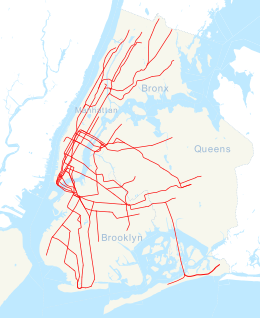


%26groups%3D_55ccc3367c6629b8db9929a7ab076713e7e694c0.svg)